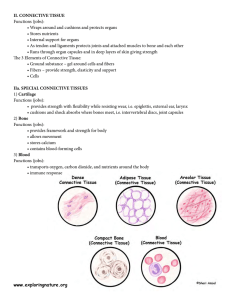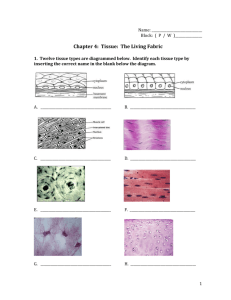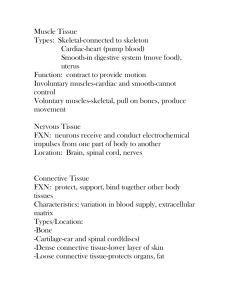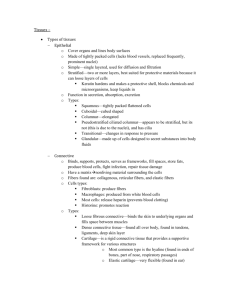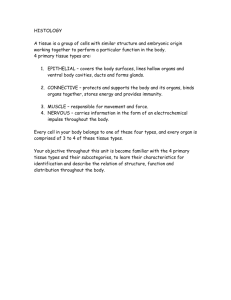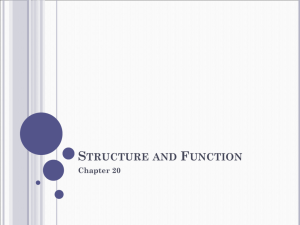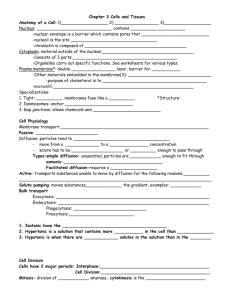RSAP Chapter 5 Histology
advertisement
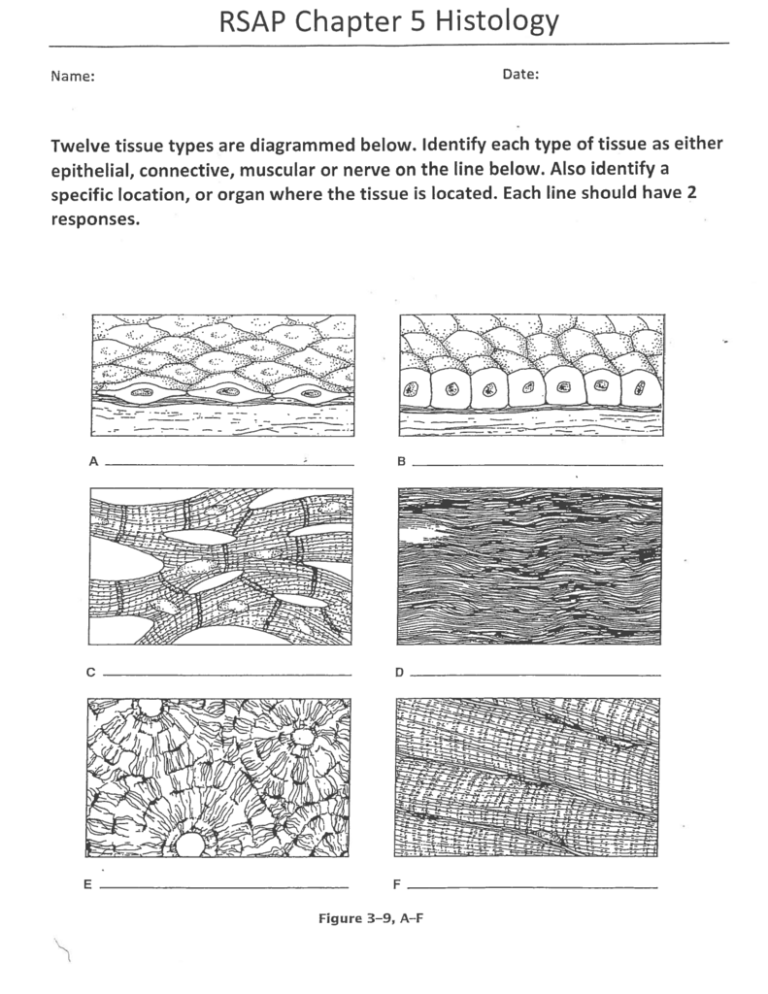
RSAP Chapter 5 Histology Date: Name: Twelve tissue types are diagrammed below. Identify each type of tissue as either epithelial, connective, muscular or nerve on the line below. Also identify a specific location, or organ where the tissue is located. Each line should have 2 responses. -- ——.— — A B C 0 - V 11111111 E F Figure 3—9, A—F ‘S o CD 0 0 CD E 0 0 CD - 0 CD CD I —. IC- 0 0 0 0 0 48 Anatomy & Physiology Coloring Workbook 21. The three types of muscle tissue exhibit certain similarities and differences. Check (/) the appropriate spaces in the following table to indicate which muscle types exhibit each characteristic. Cardiac Skeletal Characteristic 1. Voluntarily controlled 2. Involuntarily controlled 3. Banded appearance 4. Single nucleus in each cell 5. Multinucleate 6. Found attached to bones 7. Allows you to direct your eyeballs 8. Found in the walls of stomach, uterus, and arteries 9. Contains spindle-shaped cells 10. Contains cylindrical cells with branching ends 11. Contains long, nonbranching cylindrical cells 12. Displays intercalated discs 13. Concerned with locomotion of the body as a whole 14. Changes the internal volume of an organ as it contracts 15. Tissue of the circulatory pump 22. Circle the term that does not belong in each of the following groupings. 1. Collagen 2. Cilia 3. Glands 4. Adipose 5. Blood Cell Flagellum Bones Hyaline Smooth Matrix Microvilli Epidermis Osseous Cardiac Cell product Elastic fibers Mucosae Nervous Skeletal Smooth Chapter 3 Cells and Tissues 47 19. Using the key choices, correctly identify the major tissue types described. Enter the appropriate letter or tissue type term in the answer blanks. Key choices A. Connective B. Epkhelium C. Muscle D. Nervous 1. Forms mucous, serous, and epidermal membranes 2. Allows for organ movements within the body 3. Transmits electrochemical impulses 4. Supports body organs 5. Cells of this tissue may absorb and/or secrete substances 6. Basis of the major controlling system of the body 7, The cells of this tissue shorten to exert force 8. Forms hormones 9. Packages and protects body organs .__1O. Characterized by having large amounts of nonliving matrix 11. Allows you to smile, grasp, swim, ski, and shoot an arrow _12. Most widely distributed tissue type in the body __13. Forms the brain and spinal cord 20. Using the key choices, identify the following specific type(s) of epithelial tissue. Enter the appropriate letter or classification term in the answer blanks. Key Choices A. Pseudostratified columnar (ciliated) C. Simple cuboidal E. Stratified squamous B. Simple columnar D. Simple squamous F. Transitional 1. Lines the esophagus and forms the skin epidermis 2. Forms the lining of the stomach and small intestine 3. Best suited for areas subjected to friction 4. Lines much of the respiratory tract 5. Propels substances (e.g., mucus) across its surface 6. Found in the bladder lining; peculiar cells that slide over one another 7. Forms thin serous membranes; a single layer of flattened cells Chapter 3 Cells and Tissues 49 23. Using the key choices, identify the following connective tissue types. Insert the appropriate letter or corresponding term in the answer blanks. Key choices A. Adipose connective tissue C. Dense fibrous connective tissue E. Reticular connective tissue B. Areolar connective tissue D. Osseous tissue F. Hyaline cartilage 1. Provides great strength through parallel bundles of collagenic fibers; found in tendons 2. Acts as a storage depot for fat 3. Composes the dermis of the skin 4. forms the bony skeleton 5. Composes the basement membrane and packages organs; includes a gel-like matrix with all categories of fibers and many cell types 6. forms the embryonic skeleton and the surfaces of bones at the joints; reinforces the trachea 7. Provides insulation for the body 8. Structurally amorphous matrix, heavily invaded with fibers; appears glassy and smooth 9. Contains cells arranged concentrically around a nutrient canal; matrix is hard due to calcium salts 10. forms the stroma or internal “skeleton” of lymph nodes, the spleen, and other lymphoid organs Tissue Repair 24. For each of the following statements about tissue repair that is true, enter I in the answer blank. For each false statement, correct the underlined words by writing the correct words in the answer blank. 1. The nonspecific response of the body to injury is called regeneration. 2. Intact capillaries near an injury dilate, leaking plasma, blood cells, and antibodies, which cause the blood to clot. The clot at the surface dries to form a scab. 3. During the first phase of tissue repair, capillary buds invade the clot, forming a delicate pink tissue called endodermal tissue. 4. When damage is not too severe, the surface epithelium migrates beneath the dry scab and across the surface of the granulation tissue. This repair process is called proliferation. -
